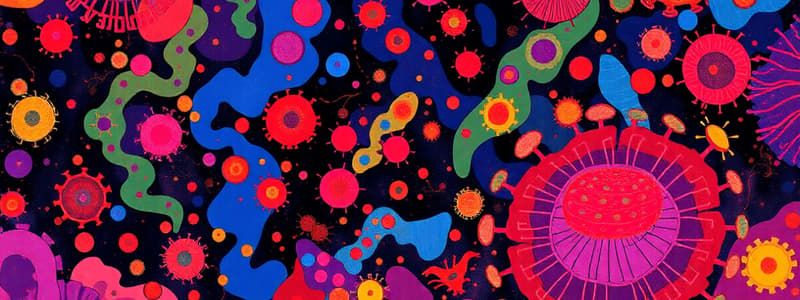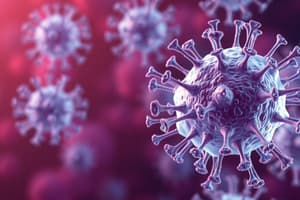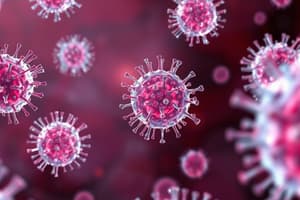Podcast
Questions and Answers
What is the primary role of antigen presenting cells (APC) in cell-mediated immunity?
What is the primary role of antigen presenting cells (APC) in cell-mediated immunity?
- To produce antibodies against foreign pathogens
- To directly kill infected cells
- To release cytokines that suppress T cell activity
- To digest antigens and display them on their surface (correct)
Which type of T cell is responsible for enhancing the activity of B cells and macrophages?
Which type of T cell is responsible for enhancing the activity of B cells and macrophages?
- Helper T cells (correct)
- Regulatory T cells
- Cytotoxic T cells
- Memory T cells
Which process occurs first following the invasion of an antigen into the body?
Which process occurs first following the invasion of an antigen into the body?
- Clonal selection of B cells
- Phagocytosis by an antigen presenting cell (correct)
- Display of antigen on Major Histocompatibility Complex
- Killing of foreign cells by cytotoxic T cells
What is indicated by a T cell count that drops below 200 cells/μl?
What is indicated by a T cell count that drops below 200 cells/μl?
How do B cell receptors (BCR) interact with antigens?
How do B cell receptors (BCR) interact with antigens?
What is the primary role of B cells in the immune response?
What is the primary role of B cells in the immune response?
Which part of the antibody is responsible for binding to antigen?
Which part of the antibody is responsible for binding to antigen?
What is the characteristic feature of IgM antibodies?
What is the characteristic feature of IgM antibodies?
Which immunoglobulin type is primarily involved in allergic reactions?
Which immunoglobulin type is primarily involved in allergic reactions?
Which statement about antibodies is incorrect?
Which statement about antibodies is incorrect?
Which characteristic differentiates adaptive immunity from innate immunity?
Which characteristic differentiates adaptive immunity from innate immunity?
What is the primary function of B lymphocytes in adaptive immunity?
What is the primary function of B lymphocytes in adaptive immunity?
Which statement about clonal selection is true?
Which statement about clonal selection is true?
What role do memory cells play in adaptive immunity?
What role do memory cells play in adaptive immunity?
In which part of the body do T lymphocytes mature?
In which part of the body do T lymphocytes mature?
Which cytokine activity is primarily associated with T cells during an immune response?
Which cytokine activity is primarily associated with T cells during an immune response?
What feature of adaptive immunity allows for a more effective response upon second exposure to an antigen?
What feature of adaptive immunity allows for a more effective response upon second exposure to an antigen?
What is a key benefit of the memory function in adaptive immunity?
What is a key benefit of the memory function in adaptive immunity?
Flashcards
Antigen Presenting Cells (APCs)
Antigen Presenting Cells (APCs)
Specialized immune cells that capture, process and display antigens on their surface for T cells to recognize.
Major Histocompatibility Complex (MHC)
Major Histocompatibility Complex (MHC)
A set of genes that code for proteins that present antigen fragments on the surface of cells. These proteins help the immune system distinguish between self and non-self.
T Cell Activation
T Cell Activation
The process by which T cells become activated by recognizing antigen presented by APCs. This leads to the development of an immune response.
Cytotoxic T Cells (CTLs)
Cytotoxic T Cells (CTLs)
Signup and view all the flashcards
B Cell Receptor (BCR)
B Cell Receptor (BCR)
Signup and view all the flashcards
Antibody structure
Antibody structure
Signup and view all the flashcards
Antibody Function
Antibody Function
Signup and view all the flashcards
Antibody isotypes
Antibody isotypes
Signup and view all the flashcards
IgG Function
IgG Function
Signup and view all the flashcards
IgM Function
IgM Function
Signup and view all the flashcards
Adaptive Immunity
Adaptive Immunity
Signup and view all the flashcards
3 Rs of Adaptive Immunity
3 Rs of Adaptive Immunity
Signup and view all the flashcards
Clonal Selection
Clonal Selection
Signup and view all the flashcards
Lymphocytes
Lymphocytes
Signup and view all the flashcards
T cells
T cells
Signup and view all the flashcards
B cells
B cells
Signup and view all the flashcards
Antigen Presentation
Antigen Presentation
Signup and view all the flashcards
Antibodies
Antibodies
Signup and view all the flashcards
Study Notes
Adaptive Immunity Lecture Notes
- Adaptive immunity is not innate, but develops over a lifetime.
- Adaptive immunity is slower than innate immunity but highly specific.
- It has a memory function.
Learning Objectives
- Features of adaptive immunity
- The 3 Rs of adaptive immunity to describe the mechanism (Recognize, Respond and Remember)
- Clonal selection
- Cell-mediated immunity
- 3 main types of T cells
- Antigen presentation
- Antibody-mediated (humoral) immunity
- B cells
- Structure and functions of antibodies
- Primary and secondary antibody responses
Features of Adaptive/Acquired Immunity
- Not present at birth, develops throughout life
- Slower to respond than the innate immune system
- High specificity for antigens
- Has a memory function
Cells Involved
- Lymphocytes are key cells
- B lymphocytes produce antibodies
- T lymphocytes are involved in cell-mediated immunity
- T cells mature in the thymus, B cells mature in bone marrow
Principles of Adaptive Immunity
- Each cell has a specific receptor for a particular antigen.
- Innate immune system cells help with antigen recognition.
- Recognition is followed by clonal selection.
- Adaptive immunity responds by:
- Cytokine secretion
- Antibody production
- Direct cell killing
Clonal Selection
- Introduced by Burnett in 1957
- Each lymphocyte has receptors to bind one specific antigen.
- The immune system is diverse - many lymphocytes with varying antigen receptors.
- Very few lymphocytes are specific to any one antigen.
- When a lymphocyte encounters its antigen, it becomes activated.
- The activated lymphocyte divides rapidly to create copies (a clone) and cells that destroy antigens.
- It also makes memory cells to protect against future encounters.
Clonal Selection Diagram
- Primary response (first encounter): antigen binding, clone formation, antibody production, memory cell development
- Secondary response (later encounter): faster response, higher antibody titre, mainly IgG, more specific antibodies, affinity maturation
Cell-mediated Immunity
- T cells need antigen-presenting cells (APCs) to introduce the antigen to them.
- APCs include phagocytes (e.g., macrophages, dendritic cells, neutrophils).
- APCs use MHC (Major Histocompatibility Complex) to display fragments of digested antigens on their surface.
Antigen Presentation Process
- Phagocyte engulfs a microbe antigen.
- Parts of the bacteria (antigens) are transported to the phagocyte's surface.
- Phagocyte presents the antigen to the helper T cell.
- This presents the T cell with information necessary to trigger a response.
Antigen Presentation Summary
- Antigen invades the body.
- Phagocytosis occurs by an antigen-presenting cell.
- Antigen is digested into particles.
- Particles are transported to the cell surface.
- The Major Histocompatibility Complex displays the antigen on the cell surface.
Cell-mediated Immunity - T cell types
- Regulatory T cells (Tregs): suppress the immune response, produce anti-inflammatory cytokine interleukin (IL)-10
- Helper T cells: produce cytokines to increase activity of B cells, macrophages, and other T cells
- Cytotoxic T cells: kill foreign or infected host cells, use perforin/granzyme system
T cell counts
- Normal T cell count range is 600-1200 cells/µl
- AIDS: count < 200/µl
B Cells & Antibodies (humoral immunity)
- B cell receptors (BCR) are antibodies
- BCRs bind to the antigen directly
- BCRs recognize specific epitopes (parts) on the antigen.
- Following clonal selection and expansion, B cells create antibodies with the same antigen-binding specificity
Antibodies (Immunoglobulins)
- Consist of two heavy chains and two light chains arranged in a "Y" shape.
- Two identical antigen-binding sites (Fab).
- The stem (Fc region) binds to Fc receptors on cells to mediate the effects of antibodies.
Antibody (immunoglobulin) structure details
- Four polypeptide chains (two heavy and two light chains)
- Each chain has a variable region (determines antigen specificity) and a constant region.
- Antigen-binding sites (Fab) composed of the variable regions of heavy and light chains.
- Fc region is made up of remaining heavy and light chain regions.
Antibody (Immunoglobulin) isotypes
- Five types of heavy chains (γ, μ, α, δ, ε), leading to 5 isotypes (IgG, IgM, IgA, IgD, IgE)
- IgG, IgE and IgD each have one Y unit
- IgA often has 2 Ig units (dimer)
- IgM has 5 Ig units (pentamer).
Antibody class details
- IgG: 70-75% of circulating immunoglobulins, 4 subclasses, can cross the placenta.
- IgM: Exists as a pentamer, important early response antibody, does not cross the placenta.
- IgA: Often exists as a dimer, predominates in secretions.
- IgD: Found in low concentrations, primarily on B cells.
- IgE: Involved in allergies, binds to mast cells and basophils.
- Antibodies perform various functions, such as neutralizing microbes/toxins, opsonization, and antibody dependent cellular cytotoxicity.
Antibody functions
- Neutralization of microbes and toxins
- Opsonization and phagocytosis of microbes
- Antibody-dependent cellular cytotoxicity (ADCC)
- Complement activation
- Inflammation
Primary vs Secondary Antibody Response
- Primary response (first exposure): takes 5-10 days, low antibody titre, mainly IgM.
- Secondary response (later exposure): faster (1-3 days), much higher antibody titre, mainly IgG, more specific antibodies, affinity maturation
Immunological Memory
- Second exposure to an antigen leads to a faster, larger, and more effective antibody response than the primary response.
- This is due to memory cells, which are long-lived and provide quicker recognition and response to the antigen.
Summary of Main Points
- Adaptive immunity is slower but highly specific, adaptable, and has memory.
- Clonal selection creates a large number of antigen-specific lymphocytes.
- T cells need APCs to present antigen.
- B cells bind antigen directly and produce antibodies matching their BCR.
- 5 isotypes (IgG, IgM, IgA, IgD, IgE) exist with diverse roles.
- Secondary antibody response is stronger and faster.
Studying That Suits You
Use AI to generate personalized quizzes and flashcards to suit your learning preferences.




